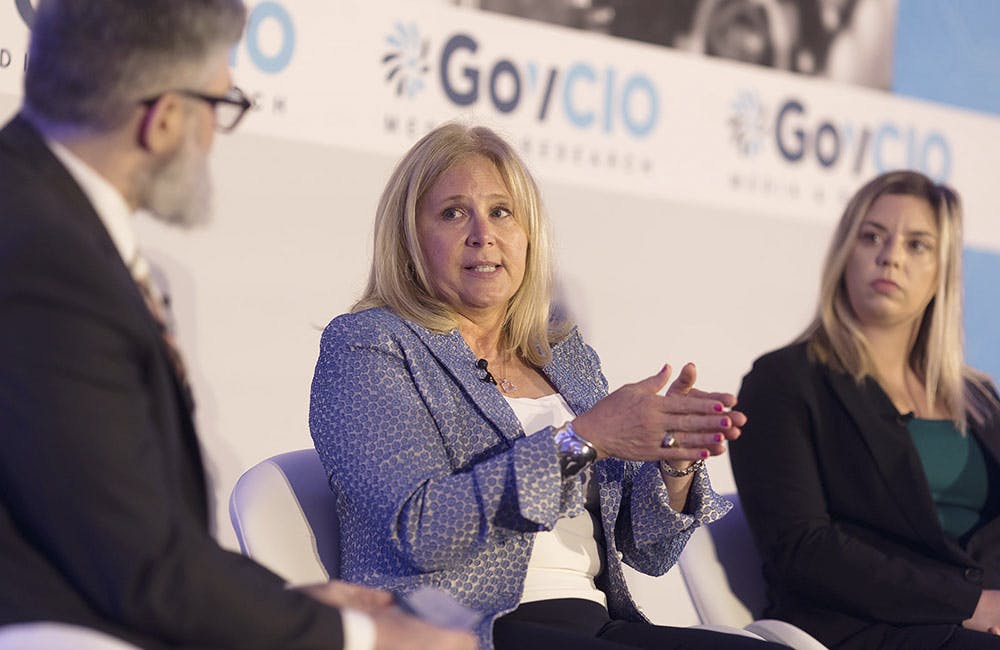Inside Army, Marines Challenges for Data Centricity Amid CJADC2
Defense officials discuss how they are tackling the services’ work in data centricity and where technology innovation fits in.

The Army and Marine Corps are tackling various data challenges as the services contribute to the Defense Department’s Combined Joint All-Domain Command and Control (CJADC2) concept and data centricity, according to officials speaking at the Defense IT Summit Friday.
Randy Young from the Army’s Program Executive Office Command, Control and Communications-Tactical (PEO C3T) outlined the Army’s role in providing capabilities from strategic to tactical levels. PEO C3T, which is responsible for delivering a unified network for the Army, is trying to reduce cognitive burden for exchanging the vast amounts of data across domains for fast decision-making.
“How do we enable that joint commander to make rapid decisions? What information do they need? What are they strategically trying to achieve, and can we get the information where we need in order to make those decisions fast?” said Young. “Then the rest of the organization for the Army is looking at now, how do I also do that for the lower echelons?”
As the Army shifts from a network-centric to data-centric environment, standards play a key role.
“Traditionally in the DOD, because of how we design our networks and how we were sharing information, we use a lot of military standards versus using commercial data platforms,” he said. “That kind of restricts what we can do broadly with data.”
The Marine Corps is also working toward data centricity. Keegan Mills, engineering and cyber technology lead at Marine Corps Systems Command, highlighted challenges including defining interoperable standards, positioning large amounts of data close to users, and building resiliency. He called out the “C” part of CJADC2 as an emphasis on coalition forces.
“Being able to leverage a coalition force means you have to have data interoperability. You have to be able to pass ones and zeros. You have to be able to communicate commanders’ intent. You have to be able to have a robust communication structure in order to do that,”said Mills.
Both Mills and Young discussed promise for artificial intelligence in processing data more quickly.
“Giving the data the ability to be processed by [large language models] and things like that — If we can crack that nut, I think that would do more to allow us to innovate faster than anything else that we’re working on right now,” said Mills. “The second most important piece is to figure out how to get machines to be able to process multiple levels of classification at machine speed.”
“Taking away cognitive burden, you know simple little workflows or apps that take that workload off of the soldiers so they can do other functions is invaluable to them in order for them to perform their mission more efficiently,” Young said. “We’re looking at that large spectrum and how do we deal with data today and how do we deal with it tomorrow.”
Both officials said there have been some shifts in policy enabling more experimentation.
“I would say within the last year, that conversation has gone from, ‘We’re never going to be cool with this,’ to, ‘Yeah, we think you’re onto something here,’ and I think that’s a very positive movement,” Mills said.
This culture of innovation is something DOD Principal Deputy CIO Leslie Beavers noted in her closing keynote session.
“Finding the innovative ideas either in the department or outside of the department, evaluating them from an enterprise perspective,” said Beavers, “and then having a deliberate pipeline that scales that innovative idea and gets it into the department at scale — because that’s where our strength is.”
This is a carousel with manually rotating slides. Use Next and Previous buttons to navigate or jump to a slide with the slide dots
-

AI Foundations Driving Government Efficiency
Federal agencies are modernizing systems, managing risk and building trust to scale responsible AI and drive government efficiency.
43m watch -

Agencies Tackle Infrastructure Challenges to Drive AI Adoption
Federal agencies are rethinking data strategies and IT modernization to drive mission impact and operational efficiency as new presidential directives guide next steps.
5m read Partner Content -

Generative AI Demands Federal Workforce Readiness, Officials Say
NASA and DOI outline new generative AI use cases and stress that successful AI adoption depends on strong change management.
6m read -

The Next AI Wave Requires Stronger Cyber Defenses, Data Management
IT officials warn of new vulnerabilities posed by AI as agencies continue to leverage the tech to boost operational efficiency.
5m read -

Federal CIOs Push for ROI-Focused Modernization to Advance Mission Goals
CIOs focus on return on investment, data governance and application modernization to drive mission outcomes as agencies adopt new tech tools.
4m read -

Fed Efficiency Drive Includes Code-Sharing Law, Metahumans
By reusing existing code instead of rewriting it, agencies could dramatically cut costs under the soon-to-be-enacted SHARE IT Act.
5m read -

Agencies Push Data-Driven Acquisition Reforms to Boost Efficiency
New initiatives aim to increase visibility of agency spending, improve data quality and create avenues to deploy solutions across government.
5m read -

Data Transparency Essential to Government Reform, Rep. Sessions Says
Co-Chair of the Congressional DOGE Caucus Rep. Pete Sessions calls for data sharing and partnerships to reduce waste and improve efficiency.
5m read -

Navy Memo Maps Tech Priorities for the Future Fight
Acting CTO’s memo outlines critical investment areas, from AI and quantum to cyber and space, as part of an accelerated modernization push.
5m read -

DOD Can No Longer Assume Superiority in Digital Warfare, Officials Warn
The DOD must make concerted efforts to address cyber vulnerabilities to maintain the tactical edge, military leaders said at HammerCon 2025.
4m read -

New NSF Program Cultivates the Future of NextG Networks
The agency’s new VINES program looks to tackle key challenges like energy efficiency and future-proofing wireless tech.
21m watch -

DHA CDAO Spearheads Master Data Catalog to Boost Transparency
Jesus Caban plans to boost DHA's data maturity through a new master data catalog, governance frameworks and inventory of tech tools.
5m read

















